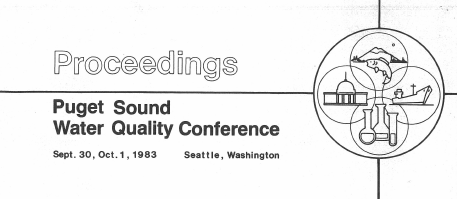Puget Sound Water Quality Conference Proceedings
The Puget Sound Water Quality Conference was held in Seattle, Washington, on September 30 and October 1, 1983. It included prominent speakers from the Puget Sound region, other parts of the United States, and Canada.

Exerpt from preface
Balanced support from 26 sponsoring organizations represented the research community, regulatory agencies, the private sector, and environmental groups. Concurrent roundtable sessions came between an opening series of major addresses and a reporting and synthesis session involving two rapporteurs with distinctive backgrounds in both environmental law and the business community. In a ddition, the interactive format encouraged questions and comments from a very broad audience. These Proceedings will enable the participants to reflect on the many insights and points raised by their colleagues and the general public, and will be welcome by a wide audience in the Puget Sound region. This continuing work toward a more coherent sense of direction regarding the future of Puget Sound is the primary goal of the Conference. The comments of Commissioner Bill Mahan, Vice President of the convening Puget Sound Council of Governments, are recommended as an able introduction to the Conference. He suggests five criteria for evaluating the Conference—that it be credible, honest, interesting, balanced, and civil. These might be reflected upon as our collective work continues in the coming years.
Without imposing a premature summary on the Puget Sound question, we can again briefly ask: "What do we really know about Puget Sound, and what does it mean?"
While the Federal Clean Water Act concentrates on biological wastes and treatment plant and industrial discharges, the new generation of issues is perhaps more threatening and difficult to correct. These include toxicants, particularly metals and synthetics, and a variety of pollutants from airborne and other diffuse sources. In the Puget Sound region, we know the sources of many pollutants and are beginning to learn about their relative contributions. We also know, however, that only a few toxicants are actually monitored. We know very little about possible synergistic or cumulative effects. However, there may be evidence that metal desposition rates for Puget Sound as a whole are no longer increasing, and in many instances are in decline. Other improvements are also identified.
We are now aware of the limited flushing capacity, and have a general understanding of recirculation patterns o f Puget Sound. Due to the complex geography, our attention is drawn to atypical sedimentation rates in sensitive embayments, particularly in urban areas. Dr. Donald C. Malins reports on fish diseases in urban and industrial embayments, relating these to levels of contamination. We do not know what level of present or future risk might exist for human consumers of non-commercial species found to be affected.
While the Conference deals with a specific geographic unit, it also enjoys a wider interest by casting this region as a focal point for more universal concerns relating the setting of environmental policy to short and long-term research findings. Direct similarities and differences were also indicated with other semi-enclosed marine systems, such as Chesapeake Bay, San Francisco Bay, and Kaneoke Bay, Hawaii.
A key institutional issue highlighted throughout this Conference is the need (difficulty) for individual decision-makers to recognize "technical" analysis as properly leading policy decisions, rather than following, and the prior need, therefore, for researchers to focus their work in a manner which is informative to others. In a separate step not reserved to any single agency or group of experts we must also assess the actual significance or insignificance of the physical evidence. I believe that it is this sense of multiple and expanding areas of knowledge which must be kept in sync with each other by a separate act of "assessment" or judgment, which often challenged and united diverse the Conference participants. Too often specialization sharpens our minds by narrowing them.
Another recurring and related theme was the need for someone to accept the challenge of mediator, or translator, between the technical research arena and the policy decision arena. The Puget Sound Council of Governments, convener of the Conference, was suggested as having a possible role. Dr. John Vandermeulen speaks thoughtfully and eloquently in his concluding remarks on the "end points" which are the basic positions taken by different parties. How far should one go in tracking and correcting ecological effects in one direction and
mutliple causes in the other?
One identified end point is budget limitations, which serve as a practical "translator" between the research arena and the political arena. This "assimilation capacity" is as real as that of the Puget Sound resource. The practical issue is one of identifying the greater environmental risks, many of which present us with exponentially rising cleanup costs, and then allocating limited budgets to the major sources of these risks. We must avoid spending ninety percent of limited resources on ten percent of the problem. This will require an
increased ability, as Dr. Bish suggests in his remarks, to make trade-offs across agency turfs. Also, the timing of the Conference still allows for preventive as well as corrective policies in Puget Sound.
We often find that increasing knowledge also increases our uncertainties ("advocacy science") rather than producing consensus, by overturning basic assumptions, (for a delightful handling of this human element, see Dr. James Warren's reference to the early settler, Dr. Henry A. Smith). Cast adrift the all too human temptation is to defend positions with casual metaphors and analogies, and selective use of facts. The contribution of this Conference was, at this point, to assemble the parties and present some of the data in a manner which invited an overall context for future work, and which fostered constructive reflection and mutual critique. Missing from these Proceedings, and not easily captured after the fact, is the marvelous sense of congeniality and mutual respect which resulted.

